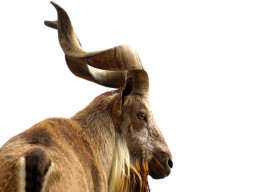
Once an endangered species, the population of the Sindh ibex, or Turkman wild goat, in Pakistan has shown significant growth in the last decade due to a blanket ban on hunting and the protection provided by local communities.
The wild goat, which is endemic to southwest Pakistan, and also found in southeast Iran, is still viewed as vulnerable, although its number has shot up to 20,000 from less than 2,000 over the past four decades. Its habitats include the Kirthar mountain range, which falls in the southern Sindh and southwestern Balochistan provinces, and the adjoining Makran range.
According to wildlife authorities, the last 10 years were crucial in terms of the increase in the population of the wild goat, which is the national animal of Sindh.
"Over 10,000 animals have been added to the population of Sindh ibex (at Kirthar National Park) during the past 10 years, which is a highly encouraging sign, considering the previous records," Wali Mohammad Birahmani, a conservator of the Kirthar National Park, told Anadolu Agency. The task to improve the wild goat population was assigned to the park authorities in 1978 when their number was nearly 2,000.
In the initial years, Birahmani said the population growth was mediocre due to hunting and poaching and a lack of awareness among the local communities vis-a-vis the threat to this animal.
Read More: Forest officials to be given arms to stop illegal hunting
"However, by the passage of time, both the issues were resolved. Thanks to the local communities that made it possible, particularly in terms of implementation of the hunting ban," Birahmani said, adding that the "untiring" efforts to protect the otherwise endangered animal yielded results during the past decade. Although common people, by and large, are not involved in hunting the vulnerable species in the mineral-rich province, the formula does not apply to the chieftains, who often invite foreign guests, especially from Gulf states, for hunting.
This, wildlife officials said, forces a good number of Sindh ibex to flee towards Kirthar National Park for refuge.
Sharif-ud-Din Baloch, the chief conservator of Balochistan Wildlife Department, admitted that "intermittent" incidents involving hunting and poaching of Sindh ibex are reported in Balochistan.
"There is a complete ban on hunting and poaching of Sindh ibex in Balochistan except for the trophy hunting. But it's difficult to fully control this phenomenon due to the huge size and insufficient workforce," he said.
"We take strict action, including imprisonment and fines, in case of violations of the ban," he told Anadolu Agency.
The number of Sindh ibex in Balochistan is between 8,000 and 10,000, according to Baloch. Balochistan's Hingol National Park, which is home to over 3,500, serves as the second-largest habitat for the animal.
Published in The Express Tribune, May 11th, 2022.





















COMMENTS
Comments are moderated and generally will be posted if they are on-topic and not abusive.
For more information, please see our Comments FAQ